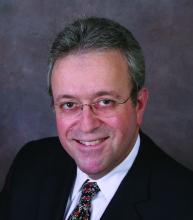In last month’s column, I discussed employees who are “clock watchers” and how to address this issue in your practice if it exists. Here’s another scenario you may encounter from the Office Politics Forum at the recent American Academy of Dermatology annual meeting:
A 40-year-old dermatologist has practiced in the same office since residency and is loved by patients and staff. He remained with the practice through its takeover by a local hospital three years previously. Recently, over a 3-month period, everyone in the office notices a change in this dermatologist’s behavior. He no longer appears happy, is argumentative with staff and patients alike, often dismisses patients’ concerns, and calls in sick during the practice’s busiest days.
. According to the American Medical Association’s National Burnout Benchmarking report, over 50% of physicians report some characteristics of burnout, which include emotional exhaustion, depersonalization, and a feeling of decreased personal achievement.
The causes of physician burnout are multifactorial and vary in importance, depending on the individual and on which authorities you consult. Here are some of the most prevalent, based on my experience and research:
Bureaucratic and Administrative Tasks: The burden of paperwork and other administrative responsibilities has increased, consuming time that could be spent on patient care or personal well-being.
Electronic Health Record (EHR) Stress: As I (and many others) have predicted for decades, the demands of EHR documentation and the associated clerical tasks have become a major source of what is now called “technostress,” detracting from the efficiency and effectiveness of healthcare delivery.
Insurance and Regulatory Demands: Navigating insurance appeals and prior authorizations, meeting regulatory requirements, and dealing with the complexities of healthcare reimbursement systems add to the stress and frustration experienced by physicians.
Lack of Autonomy and Control: As small practices consolidate, physicians often face constraints on their professional autonomy, with limited control over their work environment, schedules, and clinical decision-making, leading to feelings of helplessness and dissatisfaction.
Emotional Exhaustion from Patient Care: The emotional toll of caring for patients, especially in high-stakes or emotionally charged specialties, can lead to compassion fatigue and burnout. This may account for the results of a 2023 Medscape report in which physicians reporting the most burnout worked in emergency medicine, internal medicine, pediatrics, obstetrics/gynecology, and infectious diseases.
Work-Life Imbalance: The demanding nature of the profession often leads to difficulties in balancing professional responsibilities with personal life, contributing to burnout.
Inadequate Support and Recognition: A lack of support from healthcare institutions and insufficient recognition of the challenges faced by physicians can exacerbate feelings of isolation and undervaluation.
Addressing physician burnout requires a systems-based approach that targets these root causes at all levels, from individual coping strategies to organizational and systemic changes in the healthcare industry. Here are some strategies that have worked for me and others:
Optimize Practice Efficiency: This is the consistent theme of this column over several decades: Streamline office processes to enhance the quality of care while reducing unnecessary workload. This can involve adopting efficient patient scheduling systems, improving clinic flow, and utilizing technology like patient portals judiciously to avoid increasing the task load without compensation.
Promote Work-Life Balance: Encourage a culture that values work-life balance. This can include flexible scheduling, respecting off-duty hours by limiting non-emergency work communications, and using your vacation time. Remember Eastern’s First Law: Your last words will NOT be, “I wish I had spent more time in the office.”
Implement Medical Scribes: I’ve written frequently about this, including a recent column on the new artificial intelligence (AI) scribes, such as DeepCura, DeepScribe, Nuance, Suki, Augmedix, Tali AI, Iodine Software, ScribeLink, and Amazon Web Services’ new HealthScribe product. Utilizing medical scribes to handle documentation can significantly reduce the administrative burden, allowing physicians to focus more on patient care rather than paperwork, potentially improving both physician and patient satisfaction. (As always, I have no financial interest in any product or service mentioned in this column.)
Provide Professional Development Opportunities: Offer opportunities for professional growth and development. This can include attending conferences, participating in research, or providing time and resources for continuing education. Such opportunities can reinvigorate a physician’s passion for medicine and improve job satisfaction.
Foster a Supportive Work Environment: Create a supportive work culture where staff and physicians feel comfortable discussing challenges and seeking support. Regular meetings or check-ins can help identify early signs of burnout and address them proactively.
Evaluate and Adjust Workloads: Regularly assess physician workloads to ensure they are manageable. Adjusting patient loads, redistributing tasks among team members, or hiring additional staff can help prevent burnout.
Leadership Training and Support: Provide training for leaders within the practice on recognizing signs of burnout and effective management strategies. Supportive leadership is crucial in creating an environment where physicians feel valued and heard.
Peer Support and Mentorship Programs: Establish peer support or mentorship programs where physicians can share experiences, offer advice, and provide emotional support to each other.
Feedback and Continuous Improvement: Managers should regularly solicit feedback from physicians regarding their workload, job satisfaction, and suggestions for improvements. Actively work on implementing feasible changes to address concerns.
Dr. Eastern practices dermatology and dermatologic surgery in Belleville, N.J. He is the author of numerous articles and textbook chapters, and is a longtime monthly columnist for Dermatology News. Write to him at dermnews@mdedge.com.


